You are using an out of date browser. It may not display this or other websites correctly.
You should upgrade or use an alternative browser.
You should upgrade or use an alternative browser.
Coolant filter- an experiment
- Thread starter onion
- Start date
- Status
- Not open for further replies.
Onion thanks for the pictures... You might want to carry around a hose joiner and a pair of pliers in-case the filter lets go because it looks pretty bulgy!
Heh... yes, it is rather 'bulgy'.

I didn't realize just how distorted the filter case had become until I posted those pictures side-by-side. And upon further reflection, I decided that I'd better go buy me a better filter. The bulging alone is reason enough to conclude that this plastic fuel filter isn't suitable for this application.
So sometime this weekend I'll install the metal-cased inline fuel filter. I'll cut open the plastic filter and inspect it to see how much crud was captured and how well the filter media held up after 5 days of stop & go driving in hot weather. More pictures to come.
I'm kinda disappointed that this clear plastic filter isn't going to work for me long-term. It's really satisfying in a BITOG-OCD sense to have a visible check of my experimental filter. The metal filter won't be nearly as much fun, but it should be less of a liability.

I didn't realize just how distorted the filter case had become until I posted those pictures side-by-side. And upon further reflection, I decided that I'd better go buy me a better filter. The bulging alone is reason enough to conclude that this plastic fuel filter isn't suitable for this application.
So sometime this weekend I'll install the metal-cased inline fuel filter. I'll cut open the plastic filter and inspect it to see how much crud was captured and how well the filter media held up after 5 days of stop & go driving in hot weather. More pictures to come.
I'm kinda disappointed that this clear plastic filter isn't going to work for me long-term. It's really satisfying in a BITOG-OCD sense to have a visible check of my experimental filter. The metal filter won't be nearly as much fun, but it should be less of a liability.
What about the glass fuel/water separators used on tractor fuel lines that have a metal screen inside... Then you can still see inside it. They also use something similar for air-tools, just get the glass/metal one.
Tractor Supply Co here carries those and the water filter screen I posted above which is rated for 400F
Tractor Supply Co here carries those and the water filter screen I posted above which is rated for 400F
Yes, I think any of those could possibly work as a coolant filter. But for my own purposes, I think an inline fuel filter is ideal. I want something that's CHEAP and quick... something I can buy at the local auto parts store for about $3 and install in less than ten minutes. Also, these fuel filters will filter much finer crud than a screen can.
So this morning I removed the plastic fuel filter, which as you can see, did not hold up well to the heat. Please excuse the dim pictures... the sun is really bright out today, and my cheap camera phone doesn't do well in this kind of light.

I installed a metal Hastings fuel filter.
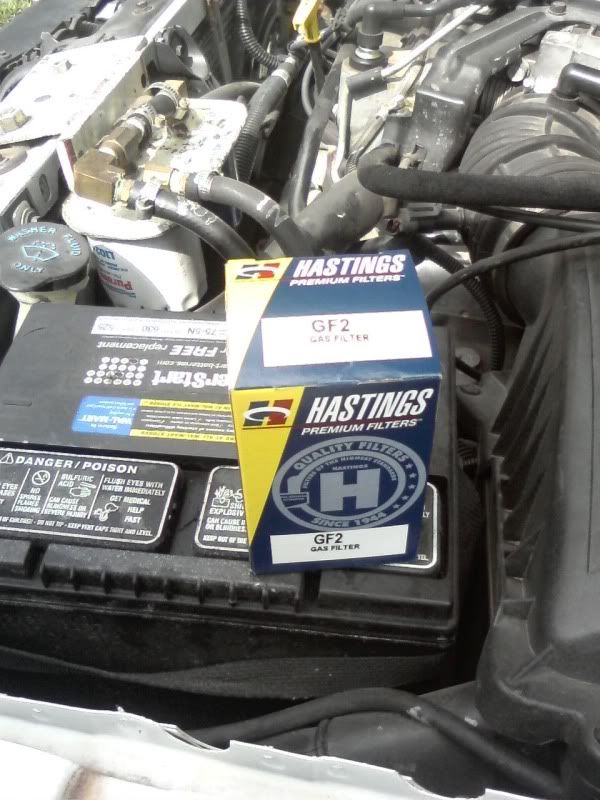
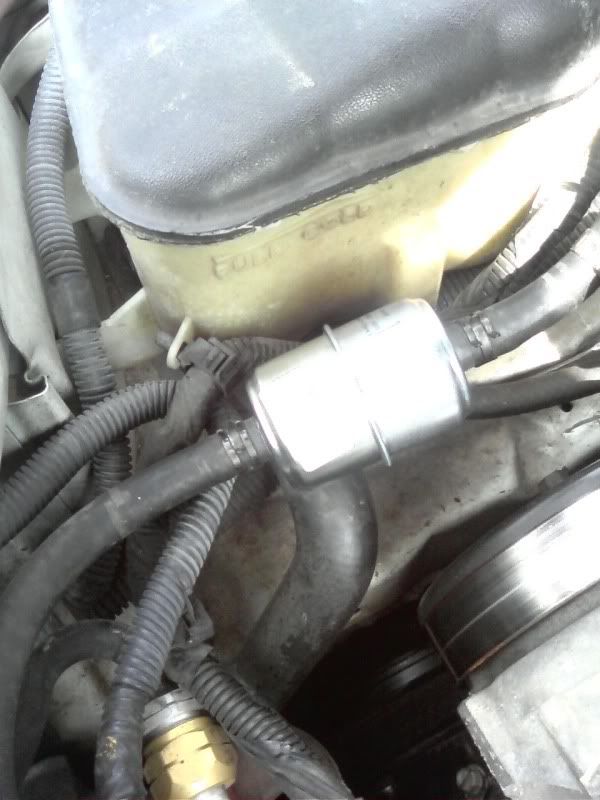
And cut open the plastic Fram filter. The paper was in good condition- not coming apart or anything, and barely distorted. The glue also held up just fine. Notice the nasty/muddy coolant dripping from the filter. This filter caught A LOT of crud in only 5 days.
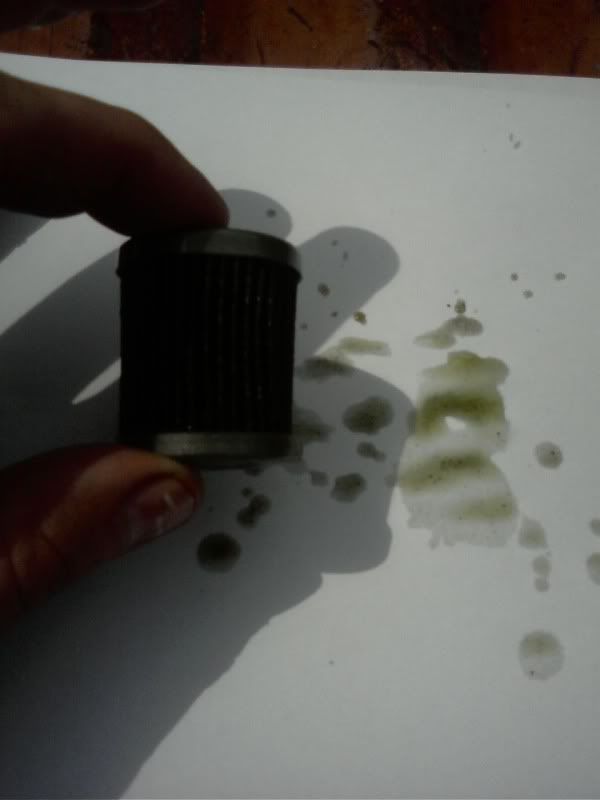
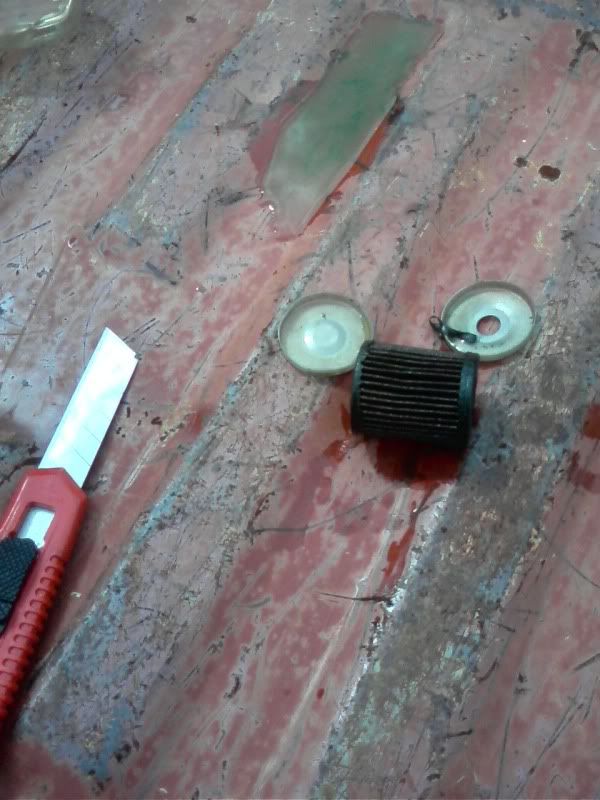
I cut the glued ends off and spread out the filter media. It may or may not be obvious in this picture, but the paper was covered with brown/black particulate sludge. I wiped the box cutter blade across just 4 inches of the paper, and you can see how much crud it accumulated. The total length of the filter media was about 24". So this is a LOT of crud captured so far.
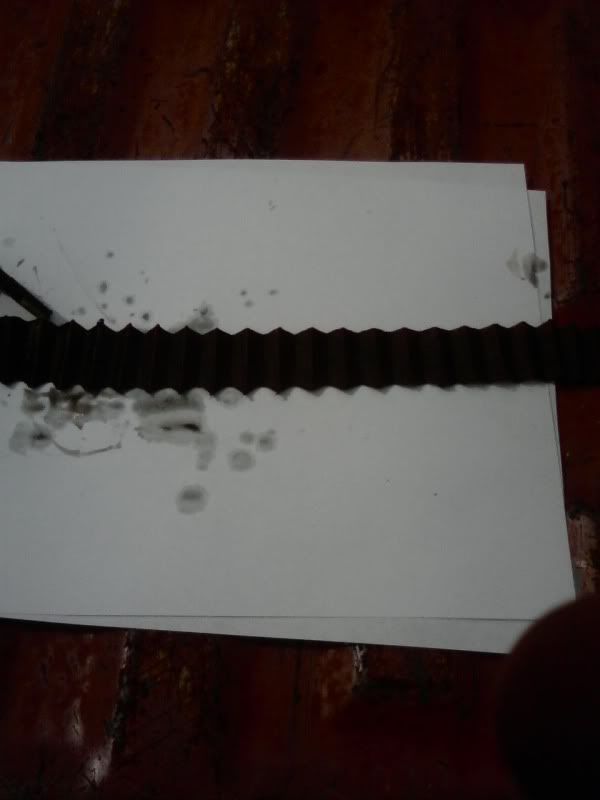
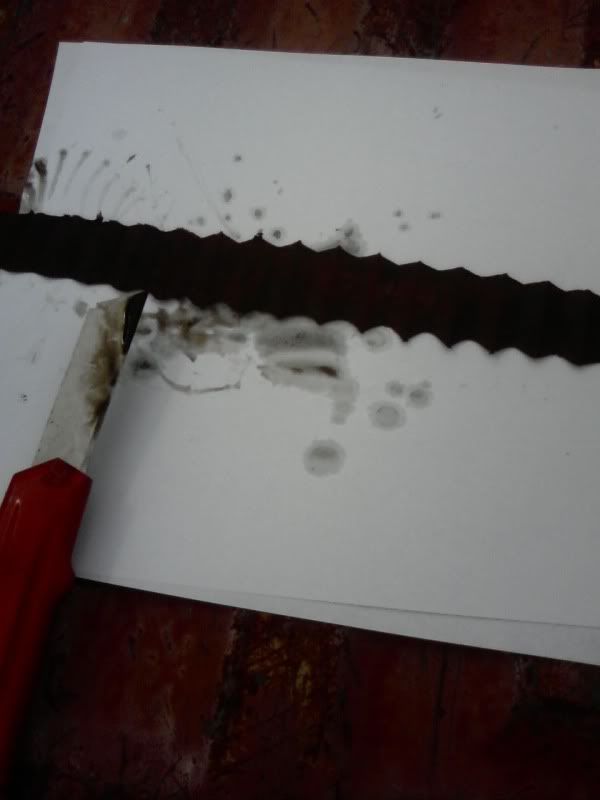
I'm operating on the assumption here that the Hastings filter will be built similarly to the Fram. I think there's a good chance that the filter media and adhesive will be water-resistant. Considering the alcohol content of gasoline these days, I expect that the filters will have to withstand polar molecules at least to SOME extent.
So this morning I removed the plastic fuel filter, which as you can see, did not hold up well to the heat. Please excuse the dim pictures... the sun is really bright out today, and my cheap camera phone doesn't do well in this kind of light.

I installed a metal Hastings fuel filter.


And cut open the plastic Fram filter. The paper was in good condition- not coming apart or anything, and barely distorted. The glue also held up just fine. Notice the nasty/muddy coolant dripping from the filter. This filter caught A LOT of crud in only 5 days.


I cut the glued ends off and spread out the filter media. It may or may not be obvious in this picture, but the paper was covered with brown/black particulate sludge. I wiped the box cutter blade across just 4 inches of the paper, and you can see how much crud it accumulated. The total length of the filter media was about 24". So this is a LOT of crud captured so far.


I'm operating on the assumption here that the Hastings filter will be built similarly to the Fram. I think there's a good chance that the filter media and adhesive will be water-resistant. Considering the alcohol content of gasoline these days, I expect that the filters will have to withstand polar molecules at least to SOME extent.
How long was the Dexcool in there before it caused so much trouble? I just drained my cooling system on my Chevy truck with the original Dexcool from 2006 and a 125k and it still looked new. I replace it with new Dexcool.
This '94 Corsica did not come with Dexcool originally. I met my wife in 2000, and this was her car at the time. At some point over the preceding 6 years, somebody put Dexcool in the cooling system. I have no idea who, when, or why... whether anything was flushed, or if it was just topped off with Dexcool. All I know for sure is that when I met my wife, her car's coolant was red and thoroghly sludged. The car had real overheating problems until I had the radiator rodded out. It's cooled just fine since then, but traces of the DexSludge remain to this day. This is in spite of multiple flushes, drain & fills, and even several attempts at washing out the radiator, coolant tank, and engine block with a steam cleaner.
Anyway, I'll probably leave this Hastings filter in place for quite a while- maybe a couple months. I'll post more pictures when I get around to replacing it and cutting it open for inspection. But my initial results with the plastic Fram filter lead me to believe that a (metal) in-line fuel filter will work just fine as a cheap/easy coolant filter.
Anyway, I'll probably leave this Hastings filter in place for quite a while- maybe a couple months. I'll post more pictures when I get around to replacing it and cutting it open for inspection. But my initial results with the plastic Fram filter lead me to believe that a (metal) in-line fuel filter will work just fine as a cheap/easy coolant filter.
Thanks for the further pics and the info...


Very interesting thread and thanks for the experiment.
I'll add my 2 cents worth.
The G2 is designed for carburetor engines. Normally that means maximum pressure of 7 psi and filtering out about 50% of particles of 100µ. As such it would be burst tested at about 14 psi to guarantee safety at 7. The same will go for a metal carburetor filter. your weak point will move to the seam.
I don't see specs for the GF2, but the cross to Wix 33032 shows the Wix at 60 psi burst and filtering out 50% of 20µ particles, so that would be a decent alternative. Maybe you can find specs for the GF2 to see where it rates.
You be much better off switching to one for a car with fuel injection, although it will clog sooner. Fuel injection filters are much finer and much higher pressures.
One other thing, the glue on some of the cheap ones doesn't even hold up for gasoline.
I'll add my 2 cents worth.
The G2 is designed for carburetor engines. Normally that means maximum pressure of 7 psi and filtering out about 50% of particles of 100µ. As such it would be burst tested at about 14 psi to guarantee safety at 7. The same will go for a metal carburetor filter. your weak point will move to the seam.
I don't see specs for the GF2, but the cross to Wix 33032 shows the Wix at 60 psi burst and filtering out 50% of 20µ particles, so that would be a decent alternative. Maybe you can find specs for the GF2 to see where it rates.
You be much better off switching to one for a car with fuel injection, although it will clog sooner. Fuel injection filters are much finer and much higher pressures.
One other thing, the glue on some of the cheap ones doesn't even hold up for gasoline.
Good points. I did a little googling around for pressure specs for the Hastings GF2 filter- no luck. But I did find an applications listing. This filter is listed for 213 PAGES worth of different applications: Everything from automotive applications back to the 1950's to forklifts to diesel tractors. I'm willing to bet that there's a pretty good safety factor built in here. And just in case, I'll keep my repair kit in the trunk.
Maybe when I'm done with this particular filter, I'll do my own burst test just for the [censored] of it. I have a pressure regulator, a gauge, and about 150psi of air pressure available.
On second thought... that might interfere with plans to cut apart this filter and see how it held up. Maybe I'll just test the new replacement filter to 50 psi or so.
Maybe when I'm done with this particular filter, I'll do my own burst test just for the [censored] of it. I have a pressure regulator, a gauge, and about 150psi of air pressure available.
On second thought... that might interfere with plans to cut apart this filter and see how it held up. Maybe I'll just test the new replacement filter to 50 psi or so.
StevieC - I just might pick up one of those strainers to install in the heater line on my Jeep. It would definitely take up less space in my already too-crowded engine bay than the dual PL30001 on an oil filter mount I was planning. It won't filter quite as well, but it should be good enough (and certainly better than no filter).
Fortunately, the engine has a bypass hose from the t-stat housing to the water pump, so the heater circuit isn't the only flow when the t-stat is closed. In other words, if the strainer clogs up, I'll only lose heat, and not hurt the engine any. The heater circuit makes up at most 1/3 of the flow with the t-stat closed.
Do you know by any chance which size strainer (3/4", 1", 1.25", 1.5") would have 5/8" or 3/4" ports on it? I'm looking on the TSC website (nearest one is an hour away), and it only lists the diameters above (probably the strainer body diameter).
Fortunately, the engine has a bypass hose from the t-stat housing to the water pump, so the heater circuit isn't the only flow when the t-stat is closed. In other words, if the strainer clogs up, I'll only lose heat, and not hurt the engine any. The heater circuit makes up at most 1/3 of the flow with the t-stat closed.
Do you know by any chance which size strainer (3/4", 1", 1.25", 1.5") would have 5/8" or 3/4" ports on it? I'm looking on the TSC website (nearest one is an hour away), and it only lists the diameters above (probably the strainer body diameter).
I have no idea, I know that you can get different size barbed hose connectors with different size threaded ends so you could have a big strainer like this but with tiny little bared hose connectors if you needed.
You can also thread brass fittings into these which is a plus so a combination of this device and home depot style fittings makes it perfect.
If you have problem finding it at your TSC store I can check out mine which has a nice selection and tell you whats available and send you one by mail if needed.
I have to go with my dad to get more salt for their water softener often (super hard water) so it's no problem.
You can also thread brass fittings into these which is a plus so a combination of this device and home depot style fittings makes it perfect.
If you have problem finding it at your TSC store I can check out mine which has a nice selection and tell you whats available and send you one by mail if needed.
I have to go with my dad to get more salt for their water softener often (super hard water) so it's no problem.
Last edited:
Ok. Thanks. I guess I'll get the big 1.5" one then (more junk holding before it clogs), and adapt it down to my 5/8" heater hoses if the ports are too big.
You might have a problem with dissimilar metals and galvanic corrosion using a metal filter in you motor.
They have plastic screen ones and brass mesh ones as well but only in selected sizes.
I would imagine stainless steel would be ok with glycol considering they use it in my waterpump.
I would imagine stainless steel would be ok with glycol considering they use it in my waterpump.
A good coolant should prevent galvanic corrosion, so I wouldn't be too worried. My coolant is fresh anyway. I flushed and filled with G-05 3 weeks ago, and had to drain half of it and re-fill when I replaced the plenum gasket over the weekend.
Originally Posted By: mechanicx
Great pics and testing. I'm a little surprised the fuel filter's plastic was giving out so quick.
I'm surprised it didn't blow apart. Its being subjected to 3x its design pressure (say 15 psi in a cooling system vs. 5 psi in a carbureted fuel system like that filter is made for) and temperatures at least 20-30F higher than its designed for (assuming the filter is in an underhood location where it might see 160F after a hot shutdown in its intended gasoline application).
Great pics and testing. I'm a little surprised the fuel filter's plastic was giving out so quick.
I'm surprised it didn't blow apart. Its being subjected to 3x its design pressure (say 15 psi in a cooling system vs. 5 psi in a carbureted fuel system like that filter is made for) and temperatures at least 20-30F higher than its designed for (assuming the filter is in an underhood location where it might see 160F after a hot shutdown in its intended gasoline application).
It looks like NAPA carries those strainers as well, and not only do I have a NAPA nearby, they're a coupe bucks cheaper too. Napa Strainer
Versus the same strainer at Tractor Supply: TSC Strainer
Versus the same strainer at Tractor Supply: TSC Strainer
Here is a Diesel Fuel Filter that is mesh screen based and comes in 3/8" and other sizes and is cheap and won't hinder your flow. It is rated for 400F as well according to the retailers specs.
If you follow the "FLOW" arrow it pushes the liquid into the inside of the mesh cylinder which is glued with a high heat epoxy on the one side of the filter head and then capped with this metal end cap shown in the picture with more of that epoxy stuff to seal it to the cap. Looks very well built and me yanking at it isn't getting it apart!




I'm using it as an inline filter for my transmission!
If you follow the "FLOW" arrow it pushes the liquid into the inside of the mesh cylinder which is glued with a high heat epoxy on the one side of the filter head and then capped with this metal end cap shown in the picture with more of that epoxy stuff to seal it to the cap. Looks very well built and me yanking at it isn't getting it apart!




I'm using it as an inline filter for my transmission!
Last edited:
- Status
- Not open for further replies.
Similar threads
- Replies
- 9
- Views
- 1K
- Replies
- 19
- Views
- 718
- Replies
- 13
- Views
- 407
- Replies
- 14
- Views
- 924
